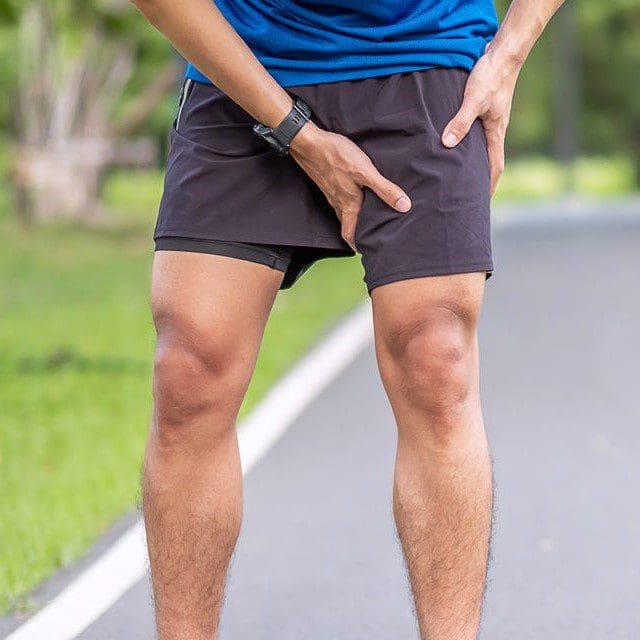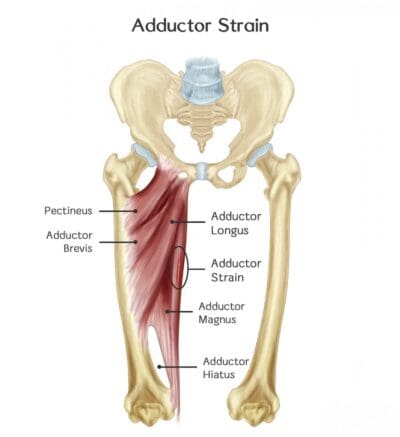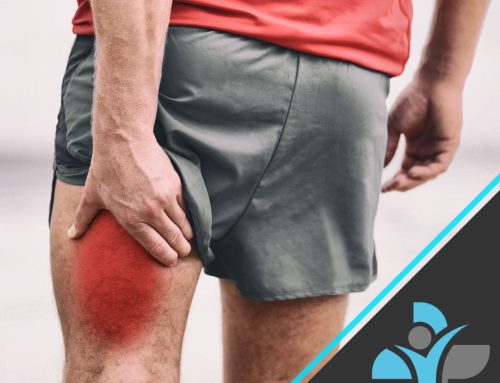
Overview
Adductor strain or injury to the adductor muscle group is a common cause of medial leg (inside leg) and groin pain, especially among athletes. A groin strain is an acute injury to the muscles on the inside of the thigh, known as the adductor muscles. These muscles help to stabilize the trunk and move the legs inward. A strain typically occurs because of an athletic injury or awkward movement of the hip joint, which leads to stretching or tearing of the inner thigh muscles.
A strain injury is graded I-III based upon its severity. Mild strains involve overstretching of the muscle, whereas more severe strains can involve complete muscle tears. Most injuries to the adductor muscles are Grades I or II.
GRADE 1 GROIN STRAIN
Grade I is a mild strain (tear) with some pain, bruising, and tenderness, but no significant fiber disruption.
GRADE 2 GROIN STRAIN
A Grade II injury involves injury to the muscle-tendon fibers, this is usually a more serious tear which will severely limit movement. However, the overall integrity of the muscle-tendon unit is preserved.
GRADE 3 GROIN STRAIN
A Grade III injury (or complete rupture) is one that results in a loss of overall muscle/tendon integrity. This serious injury will result in severe pain, swelling, joint instability, and pain associated with movement. It may in some cases mean the muscle detatching from it’s attachment point.
Anatomy
The adductor complex includes the three adductor muscles (longus, magnus, and brevis) of which the adductor longus is the most injured. All three muscles primarily provide adduction of the thigh. Adductor longus provides some medial rotation. The adductor magnus also has an attachment on the ischial tuberosity, giving it the ability to extend the hip. In open chain activation, the primary function is hip adduction. In closed chain activation, they help stabilize the pelvis and lower extremity during the stance phase of gait. They also have secondary roles including hip flexion and rotation.

Symptoms
Depending on the underlying cause, pain can be mild or severe, come on gradually or suddenly, and vary in quality (dull, sharp, throbbing, or even burning). Common symptoms include:
- Pain and tenderness in the groin and the inside of the thigh
- Sudden onset of pain sometimes accompanied by the sensation of a pop in the inner thigh
- Failure to continue activity after initial onset of pain
- Pain when you bring your legs together or when you raise your knee
- Bruising may develop, and limping may also be a symptom
Causes
Most injuries can be managed conservatively by their primary care provider with rest, ice, physical therapy, and a graded return to play.
- previous hip or groin injury
- age
- weak adductors
- muscle fatigue
- decreased range of motion
- inadequate stretching of the adductor muscle complex
Diagnosis
Radiographic evaluation is the initial modality of choice for suspected adductor strain. Anteroposterior views of the pelvis and frog-leg view of the affected hip are recommended as initial imaging studies. In most patients, these images will be normal in appearance; however, occasionally one may observe an avulsion injury. These images can also help evaluate for other causes of groin pain such as osteitis pubis, apophyseal avulsion fractures, and pelvic or hip stress fractures.
If further imaging is needed, magnetic resonance imaging (MRI) is recommended. This is likely to show muscle oedema and haemorrhage at the site of injury. If there is a bony injury, this will be better elucidated on the MRI.
Musculoskeletal ultrasound can further visualize the tendon and bony attachment sites, muscles, ligaments, and nerves. Ultrasound can be used to identify the area and extent of the injury and used to evaluate periodically during the recovery phase.
Treatment
Fortunately, there are several effective treatment options for adductor strains, including rehabilitation and massage. In this article, we will discuss the various treatment options for adductor strains, with a particular focus on the benefits of rehabilitation and massage therapy.
Rest and Ice / Heat Therapy
The first step in treating an adductor strain is to rest the affected muscle. This means avoiding any activities that put stress on the muscle, such as running, jumping, or kicking. In addition, applying ice and heat to the affected area through contrast bathing can help reduce swelling and pain and then through the heat stimulate repair. To contrast bathe we recommend 5 minutes ice, 10 minutes heat, 3 times round 3 times a day. This will equate to 45 minutes at a time.
Compression and Elevation
Compression and elevation are also important in the early stages of adductor strain treatment. Compression can help reduce swelling and provide support to the injured muscle, while elevation can help improve blood flow and reduce inflammation. A compression bandage should be applied snugly but not too tightly, and the affected leg should be elevated above the level of the heart as much as possible.
Physical Therapy / Physiotherapy
Once the initial swelling and pain have subsided, physical therapy can help restore strength and flexibility to the injured muscle. Physical therapy may include exercises to improve range of motion, strengthen the muscles, and improve balance and coordination. Your physical therapist may also use stretching, to help relieve muscle tension and improve circulation to the affected area.
Massage Therapy
Massage therapy is a type of manual therapy that involves manipulating the soft tissues of the body, including muscles, tendons, and ligaments. Massage can help reduce muscle tension and improve circulation, which can help promote healing and reduce pain and stiffness. Massage therapists may use a variety of techniques, including sports massage, deep tissue massage, myofascial release, and trigger point therapy, depending on the specific needs of the patient.
Massage therapy can be especially beneficial for adductor strains because it can help relieve muscle tension and improve circulation to the affected area. Massage can also help reduce pain and stiffness, which can make it easier to perform physical therapy exercises and other activities of daily living.
In conclusion, adductor strains can be a painful and debilitating injury, but there are many effective treatment options available. If you are experiencing symptoms of an adductor strain, it is important to seek advice for a specialist, livewell and our team of highly qualified soft tissue specialists can help. If you want to find out more information or to book an appointment, please contact us.
Exercises
An adductor strain can be a painful and frustrating injury, but with the right exercises and a progressive plan, you can get back to your normal activities in no time. It’s important to start with gentle exercises and progress gradually to more challenging ones as your injury heals. Here are some exercises you can do on a weekly basis to help recover from an adductor strain:
Week 1: Isometric Exercises
Isometric exercises involve contracting the muscle without moving it. They are gentle exercises that can help improve blood flow to the injured area and prevent further damage. To perform isometric exercises for your adductor muscles, lie on your back with your legs straight and your feet pointing up. Place a small pillow or rolled-up towel between your knees and squeeze your knees together as hard as you can for 5-10 seconds. Release and repeat for 10 repetitions, three times per day.
Week 2: Passive Stretching
After the initial pain and swelling have subsided, passive stretching can help improve range of motion and flexibility in the injured muscle. To perform a passive stretch for your adductor muscles, sit on the floor with your legs straight out in front of you. Spread your legs apart as far as you can, then gently lean forward until you feel a stretch in your inner thighs. Hold the stretch for 20-30 seconds and repeat for 3-4 repetitions, twice per day.
Week 3: Active Stretching
Active stretching involves using your muscles to move your joints through a full range of motion. It can help improve strength and flexibility in the injured muscle. To perform an active stretch for your adductor muscles, sit on the floor with your legs straight out in front of you. Spread your legs apart as far as you can, then gently push your knees down toward the floor using your inner thigh muscles. Hold the stretch for 10-15 seconds and repeat for 10 repetitions, twice per day.
Week 4: Resistance Training
Resistance training involves using weights or resistance bands to challenge your muscles and improve strength. To perform resistance training for your adductor muscles, lie on your side with your injured leg on top. Place a resistance band around your ankles and squeeze your legs together against the resistance of the band. Hold for 10-15 seconds and repeat for 10 repetitions, three times per day.
Week 5: Functional Training
Functional training involves performing exercises that mimic the movements you make in your daily activities. It can help improve balance, coordination, and overall function. To perform functional training for your adductor muscles, stand with your feet shoulder-width apart and slowly shift your weight onto your injured leg. Raise your other leg to the side as high as you can without pain, then lower it back down. Repeat for 10 repetitions, three times per day.
In conclusion, a progressive exercise plan is essential for recovering from an adductor strain. Starting with gentle isometric exercises and gradually progressing to more challenging resistance and functional exercises can help improve strength, flexibility, and overall function in the injured muscle. Be sure to consult with your healthcare provider before starting any exercise program to ensure it is safe and appropriate for your specific injury.
Prevention
- Work on core stability. Having good core and pelvic stability provides a solid base for sport-specific movements and reducing the chance of adductor strains.
- Dynamic warm-up! This is easily overlooked, but important. Prior to training and competing, ensure you perform a complete warm-up, including slow to fast movements, dynamic stretches (movement stretches) and sports-specific drills.
- Strengthen the lateral hip muscles, mainly the gluteal muscles. This will help with pelvic stability
- Stretch the inner thigh and outer thigh muscles on a daily basis.
- Regularly get manual therapy and massages from certified physiotherapists, athletic therapists or massage therapists. This will help to get the muscles flexible and break down any trigger points or scar tissue that can lead to injury.
- Practice sport-specific drills, change of direction and cutting manoeuvres which commonly cause groin strains. This will help the muscles to adapt and become stronger at performing this kind of movement.
- Strengthen the inner thigh muscles using weight machines and resistance bands. It is especially important to strengthen the muscles in the movement which caused the injury, to prevent a reoccurrence.
- Improve your proprioception. This is our sense of where each body part is in space and is similar to balance. Proprioception affects the way we move, especially when our balance is compromised and is therefore important in avoiding all injuries.
- Get plenty of rest and avoid over-training! If you train too much or for too long fatigue sets in, which increases the risk of injury.



